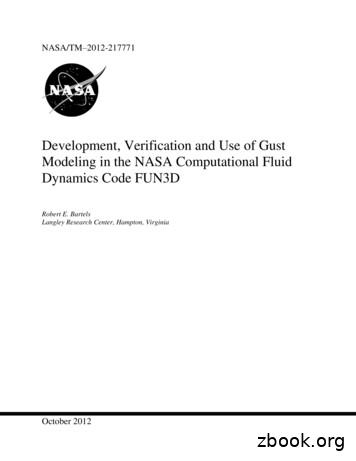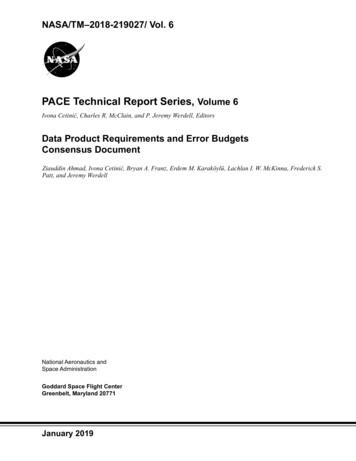TECHNICAL NOTE - NASA
D-552Z ZTECHNICAL EIN SLUSHROLLINGORONWATERWalter B. Horne,UpshurT. Joyner,and TraffordJ. W. LelandLangley ASHINGTONANDCenterVa.SPACE ADMINISTRATIONSeptember1960AN
FTNOTERETARDATIONTIREBy DSLUSHONANOR WATERB. Horne,UpshurT. Joyner,TraffordJ. W. LelandLi260SPACESUMMARYA seriesof unbraked(freelyrolling)the Langleylanding-loadstrack with a 32ribbed-treadaircrafttire to obtaindatadevelopedduringrollingof the tests rangedfrom350and115poundspertaxi tests were conductedat 8.8, type VII, 22-ply-ratingon tire retardationforcesin both slush and59 to 104 knots.squareinchwerewater.The forwardspeedsTire inflationpressuresofused.Resultsindicateda parabolicincreaseof retardationforce withincreasingforwardvelocityfor both slushand water-coveredrunwaysurfaces.The retardationforce was found to increaseapproximatelylinearly with increasingwaterdepth.Drag coefficientsappropriateto theequationsused are presented.Calculationsmade to determinethe effectof slush on the take-offdistanceof a jet transportare in agreementwithdata obtainedfrom an actualtake-offin slush for this airplane.theThis is anaccelerationinterimreportwhichdeals withand the ground-rundistanceofthe effectof slush gein this countryhas focusedattentionon the problemof take-offand landingon runwayscoveredwithslush or water.This problemhasbeen toleratedon propeller-typeaircraftbecauseits effecton aircraftperformancedid not usuallyresultin unsafeoperation.However,themuch highertake-offand landingvelocitiesrequiredof the new jets alongwith their lower accelerationcharacteristicsmakesthis problemand itseffecton aircraftperformancemuch more acute.This operatingproblemaffectsaircraftperformancein severalways.First,the retardationforcesdevelopedby the aircraftwheelswhen takingoff from slushorwater-coveredrunwaysincreasethe take-offdistancerequiredby the rplanefrom
2obtaining the required take-off velocity.Second, the high-velocityspray of slush or water originating from the airplane wheels can bedamaging to the surfaces of the airplane that are under spray impingement. Third, under certain conditions of vertical load, tire-inflationpressure, and forward speed, airplane tires operating on slush- or watercovered runways reach a condition called aquaplaning during which thehydrodynamic liftforce developed between the tire footprint and thefluid-covered runway surface equals or exceeds the vertical reaction ofthe airplane mass acting on the tire.During aquaplaning the tire losescontact with the runway surface and thus loses its directional stabilityand braking effectiveness.Fourth, at subaquaplaning velocities thefrictioncoefficients developed between aircraft tires and the groundduring braking on slush- or water-covered runways are considerably reducedfrom the values obtained on dry runways. The tire tread pattern mayinfluence this effect to a certain extent.A general investigation under controlled conditions has been underway at the Langley landing-loads track (ref. l) to determine the effect offorward velocity; type of runway surface; tire tread material, pattern,and wear; water and slush on the runway; and so forth on the braked andunbraked characteristicsof aircraft tires.This investigation is continuing, but, because of great current interest in the effects of slushor water-covered runways on jet-transporttake-off performance, thisreport is being issued to present the results obtained thus far for afreely rolling (unbraked) wheel operating on a slush- or water-coveredconcrete runway.Also presented herein are methods for calculating (i) the retardation force developed on an unbraked tire due to slush or water and(2) the additional take-off distance required for an airplane operatingon a slush- or water-covered runway over that required on a dry runway.The calculated and actual take-off distances required for a fourengine jet transport operating in 0.6 inch of slush are ryrunwayanaircrafthorizontalaccelerationon eofcrossaircraftsectiondueattoslushslushor wateror watersurfaceLi260
3CDdragCztire constant;0.02 for type I tires andand VII tires(obtainedfrom ref. opedona staticslushortiretireor waterverticalloadminusforce)of inertiatube)leadingofN mnumberofNnnumberof nose-wheelPtirePrrated tirepressure)r ireburstingtire,
3inchwereisshownandthemountedairplane.rotating- toThissimilarsnowice4.
used was the fine residueleft from chippingblockice.largerparticlesrarelyexceeded1/4 inch in diameter.beforea estainlesstakensteel,byfittedThe occasionalImmediatelymeanswithofa 6- by6-bya transparent32top, and havingone end open.The edges of the open end weresharpenedto allow the box to be pushedgentlythroughthe slush withoutcompressingthe sample.When the bottomof the box was completelycoveredwith slushas noted throughthe transparenttop, the open end was closedwith a hardrubbercover,trappingthe slush and waterinside.The box was thenLi260weighed,of waterprocedureand this weightwas comparedwith the weightof an equal volumeto give the specificgravityof the slush sample.This samecould be used to measureequivalentslush depth.In figure5(a) is shown the snow ice beingtrough.The sled shown in figure5(b) containedcouldslushtrim the slush totroughimmediatelydepositedin the slushan adjustableplate thatthe desiredtest depth.The appearanceofafter a test run is shown in figure5(c).theINSTRUMENTATIONInstrumentationwas providedto obtainthe verticaland drag forcesdevelopedbetweenthe tire and the runway.Also obtainedwere the vertical and drag accelerationsof the wheelaxle as well as the wheelangularacceleration,velocity,and displacement.Side load was not measuredduringthese tests.All forceswere measuredby strain-gagedynamometerbeams.Becauseof space limitationswithinthe test fixture,some ofthe instrumentswere mountedon an auxiliaryaxle which was drivenataxle speed from the main axle by a toothedtimingbelt.Figure6 is aschematicdiagramof the test fixtureand shows the locationof thevariousinstruments.The verticalload betweenthe tire and the runwaywas obtainedbyaddingthe measuredverticalload from each vertical-loadbeam; the sumof the two drag-beammeasurementsgave the drag load.Correctionsforthe inertiaforcesintroducedby the mass of the wheel,tire, andassembly(due to runwaysurfaceirregularities)were derivedfromerationat onevaluesobtainedend of the axle.i0 to 15 percentof theThe weightof the wheel,fromTheaxleaccel-the verticaland drag accelerometersmountedinertiacorrectionsamountedto no more thanmeasuredvaluestire and axleof the verticaland dragassemblywas 780 pounds.load.
The horizontal velocity of the main carriage was measuredby notingthe time taken to travel a given incremental distance. Distance measurements were obtained by the use of metal tabs at lO-foot intervals alongthe side of the track.Whena tab interrupted the light beamin a lightsourceuphotocell combination mounted on the main carriage, a pulseoccurred on an oscillograph-record trace.TESTPROCEDUREBeforeeach simulatedtaxi run, the slush and waterdepthsweremeasured.It shouldbe mentionedthat the waterdepth was extremelydifficultto controldue to wind effects.A wind blowingalong thelengthof the track tendedto slope the water towardthe far end of thewatertrough.All runs were made with the wheel unbraked(freelyrolling).The verticaltroughswasTheentperload on theapproximatelyinvestigationforwardsquaretire whiletraversing9,000 pounds.consistedvelocitiesinch.Theofa seriesat tire eratdiffer-pressuresof 350 and ll5 poundsvariedfrom 59 to 104 knots.The slush depth was held constantat approximatelywaterdepth variedbetweenapproximately0.3 e historiesof a typicalrun on slushand water-coveredrunwaysurfacesare shown in figure7.In this particularrun the tire aquaplaned.This fact is substantiatedby the wheel-angular-velocitycurvewhichshows the wheellosingapproximatelytwo-thirdsof its dry runwayangularvelocitywhile on the slush-coveredrunway.Tire planingis alsoindicatedby the displacementcurvesshown in figure7.The differencesbetweenthe carriagedisplacementand computedverticaltire deflectioncurvesare a directmeasureof the verticalaxl
ribbed-tread aircraft tire to obtain data on tire retardation forces . 0.02 for type I tires and 0.03 for types III and VII tires (obtained from ref. 2) diameter of unloaded tire fluid depth on runway function of tire width . In this particular run the tire aqua-planed. This
2016 nasa 0 29 nasa-std-8739.4 rev a cha workmanship standard for crimping, interconnecting cables, harnesses, and wiring 2016 nasa 0 30 nasa-hdbk-4008 w/chg 1 programmable logic devices (pld) handbook 2016 nasa 0 31 nasa-std-6016 rev a standard materials and processes requirements for spacecraft 2016 nasa 0 32
Jan 10, 2012 · The NASA STI program provides access to the NASA Aeronautics and Space Database and its public interface, the NASA Technical Report Server, thus providing one of the largest collections of aeronautical and space science STI in the world. Results are published in both non-NASA channels and by NASA in the NASA
The NASA STI program provides access to the NASA Aeronautics and Space Database and its public interface, the NASA Technical Report Server, thus providing one of the largest collections of aero-nautical and space science STI in the world. Results are published in both non-NASA channels and by NASA in the NASA
The NASA STI program provides access to the NASA Aeronautics and Space Database and its public interface, the NASA Technical Report Server, thus providing one of the largest collections of aero-nautical and space science STI in the world. Results are published in both non-NASA channels and by NASA in the NASA STI Report Series, which includes
The NASA STI program provides access to the NASA Aeronautics and Space Database and its public interface, the NASA Technical Report Server, thus providing one of the largest collections of aero-nautical and space science STI in the world. Results are published in both non-NASA channels and by NASA in the NASA STI Report Series, which includes
to the NASA Technical Report Server—Registered (NTRS Reg) and NASA Technical Report Server— Public (NTRS) thus providing one of the largest collections of aeronautical and space science STI in the world. Results are published in both non-NASA channels and by NASA in the NASA STI Report Series, wh
The NASA STI Program operates under the auspices of the Agency Chief Information Officer. It collects, organizes, provides for archiving, and disseminates NASA’s STI. The NASA STI Program provides access to the NASA Technical Report Server—Registered (NTRS Reg) and NASA Technical Report Server
to the NASA Technical Report Server—Registered (NTRS Reg) and NASA Technical Report Server— Public (NTRS) thus providing one of the largest collections of aeronautical and space science STI in the world. Results are published in both non-NASA channels and by NASA in the NASA STI Report Series, wh






















